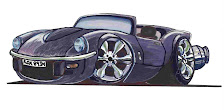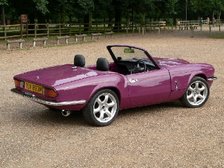What a trip................

I was a little apprehensive about doing this trip, mainly because my car had only covered about 2500 miles since its rebuild and I was about to double it. I
needn't have worried, the car ran very well. I had spent the last couple of weeks checking, greasing etc etc and did not really expect to have any issues but you never really know in a car that is over 30 years old.
We averaged 27/28 mpg over the 2500 miles, 35 mpg was the best and 21 mpg the worst while tackling the mountain routes around
Stelvio.
At one point we did suffer steering column shake and vibration but this was quickly diagnosed when the radio fell out and I realised that the H frame bolts had come undone.
We had another issue with a change in exhaust note and strange vibration which did get me a little worried, once we pulled into the service station this changed to a rattle from under the car, after a quick inspection, I found that the exhaust hanger U bolt had come loose, this was tightened and everything was fine again.
Apart from a little tyre to bodywork contact,
that's about it.
I did learn quite
alot about the car, this has given me a couple of things to investigate.
I had fitted 100 Watt bulbs for the event, while these were superb in complete darkness, with no reflective road markings or signs, If you tried to use main beam on anything
reflective you were
immediately blinded. My plan to overcome this is to fit some HID lights,
they'll be the topic of another post.
My car handled
exceptionally well, even in very wet conditions, what it
didn't like was crossing road expansion joints in mid corner at high speeds, this became quite uncomfortable when going through series of tunnels during the trip. Not sure what I'm going to do about this as I cant slow down....... I think it looked more dramatic from the cars that were following as the car moved around. I
don't plan on changing the wheel and tyre set up so I think I will have a mess around with the damping.
Developed a couple of oil leaks, one from the head gasket and one from the front crank seal, all pretty much standard stuff.
Might have a play around with diff ratios as the car does lack a little pull away performance, I think this is due to having 215/40 R16 tyres. I'm currently running with a 3.89 diff, I plan to swap this in the next few weeks to a 4.11 and see how that goes. I will happily trade some top speed for more acceleration.
I guess the only other thing to mention is that I had a pretty good co-driver, my brother Andy, he was quite happy to sit back and let me drive, when he did drive, he respected the fact that this was my car. We also met some great people during the event, only problem being that I
didn't really remember any names but I'm sure we will meet up on future events.
The
following link should take you to a short video of the GT6 at the
Nurburgring http://uk.youtube.com/watch?v=_Ut2zz2841wThanks to Ellis and all at Club Triumph who organised the event.
 Not sure where I originally picked up this valve.
Not sure where I originally picked up this valve. The valve pushes into the modified distributor housing and is held in with a small cap head bolt.
The valve pushes into the modified distributor housing and is held in with a small cap head bolt. Fits quite neatly on the side of the block
Fits quite neatly on the side of the block Plumbed into the intakes via some 1/2" tubing pressed into the end of the manifolds.
Plumbed into the intakes via some 1/2" tubing pressed into the end of the manifolds.
 Alloy hubs with larger stub axle and improved bearings.
Alloy hubs with larger stub axle and improved bearings.
 And a very nice pair of AP Racing calipers, couldn't believe how light these calipers are, a friend has promised to get me a set of decent pads, they should arrive over Christmas.
And a very nice pair of AP Racing calipers, couldn't believe how light these calipers are, a friend has promised to get me a set of decent pads, they should arrive over Christmas.








 I used some aftermarket seat runners as the seats I bought didn't have any, the inner runner needs to be modified to match the seat pan. On my setup I used the original MX5 seat mounting points on the outer runner and the front fixing on the inner runner, I welded in a nut for the rear fixing on the inner runner.
I used some aftermarket seat runners as the seats I bought didn't have any, the inner runner needs to be modified to match the seat pan. On my setup I used the original MX5 seat mounting points on the outer runner and the front fixing on the inner runner, I welded in a nut for the rear fixing on the inner runner. I used Securon seat belts with short steel stalks and bolted these directly to the seat in place of the MX5 seat belt stalk. There are slight differences between the driver and passenger seat but you basically make the same modifications.
I used Securon seat belts with short steel stalks and bolted these directly to the seat in place of the MX5 seat belt stalk. There are slight differences between the driver and passenger seat but you basically make the same modifications.








 Following numerous cardboard templates I have come up with something that seems to work quite well, I have fabricated an air box with filter that sits below the radiator.
Following numerous cardboard templates I have come up with something that seems to work quite well, I have fabricated an air box with filter that sits below the radiator.




 I don't expect a performance increase from any forced air effect but it should help overcome some of the restrictions of the filter and trunking. Having driven the car with the old and new intakes there is no noticeable difference in performance when travelling at speed.
I don't expect a performance increase from any forced air effect but it should help overcome some of the restrictions of the filter and trunking. Having driven the car with the old and new intakes there is no noticeable difference in performance when travelling at speed.
 This hose is fitted with a 4mm restrictor, the idea being that as the pump draws coolant, from the radiator and header tank, it creates a lower pressure in the header tank, this in turn should draw any air in the thermostat housing back into the header tank.
This hose is fitted with a 4mm restrictor, the idea being that as the pump draws coolant, from the radiator and header tank, it creates a lower pressure in the header tank, this in turn should draw any air in the thermostat housing back into the header tank. Made up a couple of pipes that fix to the rocker cover studs to keep it all looking tidy. Unfortunately not very easy to see in this picture.
Made up a couple of pipes that fix to the rocker cover studs to keep it all looking tidy. Unfortunately not very easy to see in this picture. 





 Next job was to get the engine back in, as the gearbox and bonnet are still fitted, I thought I would treat myself to an engine load leveller to aid re-fitting the engine - set off down to machine mart at 4:30 yesterday only to find they had sold the one they had that morning - sods law - not to worry, I have now ordered one off the
Next job was to get the engine back in, as the gearbox and bonnet are still fitted, I thought I would treat myself to an engine load leveller to aid re-fitting the engine - set off down to machine mart at 4:30 yesterday only to find they had sold the one they had that morning - sods law - not to worry, I have now ordered one off the  I will fit the front pulley when the engine is back in, I currently have it at work as I am using it to make a boss to hold a 36-1 trigger wheel for a friends
I will fit the front pulley when the engine is back in, I currently have it at work as I am using it to make a boss to hold a 36-1 trigger wheel for a friends 










